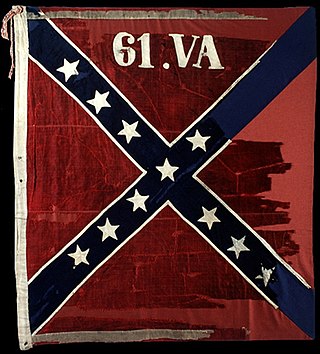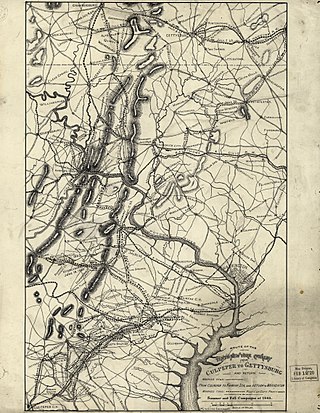The Stonewall Brigade of the Confederate Army during the American Civil War, was a famous combat unit in United States military history. It was trained and first led by General Thomas J. "Stonewall" Jackson, a professor from Virginia Military Institute (VMI). His severe training program and ascetic standards of military discipline turned enthusiastic but raw recruits into an effective military organization, which distinguished itself from the First Battle of Bull Run in 1861 to Spotsylvania Court House in 1864. Its legacy lives on in the 116th Infantry Brigade, which bears the unofficial nickname "Stonewall Brigade," and in several living history reenactment groups.
The 51st Georgia Infantry Regiment was an infantry regiment in the Confederate States Army during the American Civil War.
The 5th Wisconsin Infantry Regiment was an infantry regiment that served in the Union Army during the American Civil War.

Hampton's Legion was an American Civil War military unit of the Confederate States of America, organized and partially financed by wealthy South Carolina planter Wade Hampton III. Initially composed of infantry, cavalry, and artillery battalions, elements of Hampton's Legion participated in virtually every major campaign in the Eastern Theater, from the first to the last battle.

The 1st Virginia Infantry Regiment was an infantry regiment raised in the Commonwealth of Virginia for service in the Confederate States Army during the American Civil War. It fought mostly with the Army of Northern Virginia.

The 18th Virginia Infantry Regiment was an infantry regiment raised in Virginia for service in the Confederate States Army during the American Civil War. It fought mostly with the Army of Northern Virginia.

The 61st Virginia Infantry Regiment was an infantry regiment raised in Virginia for service in the Confederate States Army during the American Civil War. It fought mostly with the Army of Northern Virginia. The core of what would become the 61st Virginia was organized in Norfolk, Virginia in summer 1861 as the 7th Battalion, Virginia Reserves with eight companies. It served as heavy artillery in the Portsmouth and Norfolk area. However, when these cities were evacuated, the unit was transferred to the infantry and merged into the 61st Regiment being formed in Petersburg, Virginia in October 1862. Lieutenant Colonel Samuel M. Wilson was placed in command. The men of the 61st Virginia were from Portsmouth, and the counties of Norfolk, Isle of Wight, and Greensville. It was assigned to General Mahone's Brigade and which became General Weisinger's Brigade, Army of Northern Virginia upon General Mahone's promotion to Division Commander.

The 1st Virginia Cavalry Regiment was a cavalry regiment raised in Virginia for service in the Confederate States Army during the American Civil War. It fought mostly with the Army of Northern Virginia.

The 2nd Virginia Cavalry Regiment was a cavalry regiment raised in Virginia for service in the Confederate States Army during the American Civil War. It fought mostly with the Army of Northern Virginia.

The 4th Virginia Cavalry Regiment was a cavalry regiment raised in Virginia for service in the Confederate States Army during the American Civil War. It fought mostly with the Army of Northern Virginia.

The 9th Virginia Cavalry Regiment was a cavalry regiment raised in Virginia for service in the Confederate States Army during the American Civil War. It fought mostly with the Army of Northern Virginia.

The 10th Virginia Cavalry Regiment was a cavalry regiment raised in Virginia for service in the Confederate States Army during the American Civil War. It fought mostly with the Army of Northern Virginia.

The 11th Virginia Cavalry Regiment was a cavalry regiment raised in Virginia for service in the Confederate States Army during the American Civil War. It fought mostly with the Army of Northern Virginia.

The 13th Virginia Cavalry Regiment was a cavalry regiment raised in Virginia for service in the Confederate States Army during the American Civil War. It fought mostly with the Army of Northern Virginia.

The 17th Virginia Cavalry Regiment was a cavalry regiment raised in Virginia for service in the Confederate States Army during the American Civil War. It fought with the Army of Northern Virginia, in southwestern Virginia, and in the Shenandoah Valley.
The 13th Ohio Cavalry Regiment was a cavalry regiment that served in the Union Army during the American Civil War.
The 19th Mississippi Infantry Regiment an infantry formation of the Confederate States Army during the American Civil War. As part of the Army of Northern Virginia, the 19th Regiment fought in numerous battles of the Eastern Theater. It was successively commanded by Colonels Christopher Mott, Lucius Lamar, Nathaniel Harris, Thomas Hardin, and Richard Phipps.

The 10th New York Cavalry Regiment was a cavalry regiment that served in the Union Army during the American Civil War.
The 1st Pennsylvania Cavalry was a cavalry regiment that served in the Union Army as part of the Pennsylvania Reserves infantry division during the American Civil War.
The 41st United States Colored Infantry was an infantry regiment that served in the Union Army during the American Civil War. The regiment was composed almost entirely of African American enlisted men and commanded by white officers. The regiment was authorized by the Bureau of Colored Troops which was created by the United States War Department on May 22, 1863. The regiment engaged in the Siege of Petersburg and Appomattox Campaign and was present at the unconditional surrender of Confederate General Robert E. Lee and the Army of Northern Virginia at Appomattox Court House on April 9, 1865.





